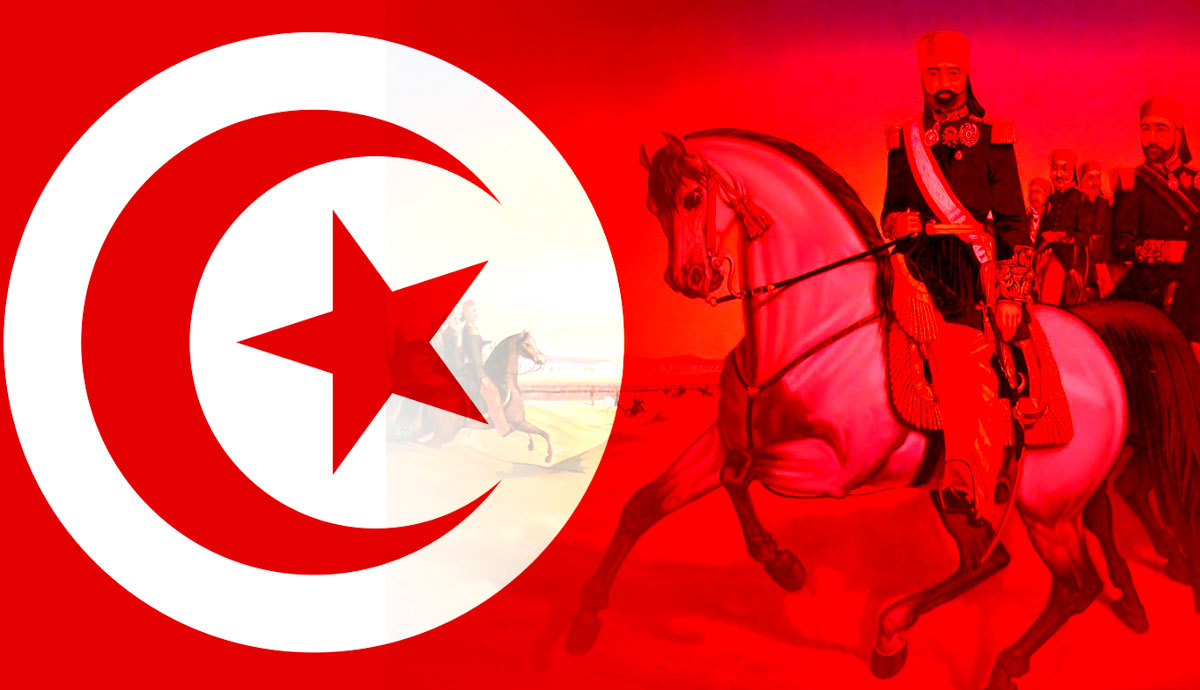
Tunisia is in the Maghreb region along the coast of North Africa between Libya and Algeria. Tunis, the capital, has long been a prosperous port city along Mediterranean trade routes. Historian Jamil Abun-Nasr explains that the first recorded settlers were called “Libyans” though better classified as Berbers in the tenth century BCE. The country has experienced centuries of imperial conquests from the Romans to the French in the nineteenth century. Nationalists led by Habib Bourguiba secured Tunisian independence in 1956.
Revolving Door of Dynasties

Tunisia is perhaps best known as the heartland of the ancient Mediterranean power, Carthage. Founded as a colonial outpost by Phoenicians from the port city of Tyre, Carthage later emerged as a Mediterranean imperial power. Carthage’s growing power led to conflict with the Roman Republic. Rome ultimately defeated Carthage in the three Punic Wars.
The Romans called the conquered province Africa, which would later give its name to the continent. Moreover, the Romans also revived the city of Carthage, which had been destroyed. Indeed, Carthage emerged as a dynamic center of Christianity in Roman North Africa.
Roman rule was followed by a succession of invaders. In 670 CE, Tunisia fell to Arab conquerors, an event that introduced Islam to the country. By the ninth century, Kairouan emerged as a major Islamic learning and commercial center.
Ottoman Rule?

Ottoman forces gained a foothold in the Maghreb region through the 1516 conquest of Algiers. The Ottomans, though, essentially ruled much of North Africa indirectly. For example, Tunisia essentially remained under the control of the Hafsid dynasty between 1229 and 1574.
The Hafsids presided over a flourishing commercial empire centered on Tunis. As historian Jamil Abun-Nasr points out, Muslim and Christian merchants across the Mediterranean engaged in trade with Hafsid Tunis. However, by the 16th century, the Hafsids were locked in a conflict with the Spanish and Ottoman-backed pirates.
For instance, the famous naval commander and privateer Hayreddin Barbarossa led the first Ottoman conquest of Tunis in 1534. A second Ottoman conquest of Tunis in 1574 established the Regency of Tunis.
But as before, Ottoman rule was distant, with power exercised by local officials on behalf of the sultan. In the sixteenth century, appointed Ottoman officials, known as pashas, saw their influence reduced in favor of two other administrators. The first of these was the military commander, known as the Dey. The other official, the Bey, was responsible for various administrative tasks, including collecting taxes.
By the early seventeenth century, the Bey had become a more powerful official. As a result, Tunisia’s rulers assumed the title of Bey or Lord. In 1613, a janissary of Corsican origin named Murad Bey established the Muradid dynasty in Tunisia. The death of the last Muradid ruler, Muradid II Bey, in 1675 plunged Tunisia into a civil war known as the Revolutions of Tunis. Moreover, once again, Spanish forces tried to seize Tunisia.
The Husaynid Dynasty

Amid Spanish attacks and civil war, Tunisia’s next ruling dynasty, the Husaynids or Husianids, took control of the Regency of Tunis in 1705. The dynasty’s founder, Al-Husayn I ibn Ali at-Turki, assumed power and ended the years of political turmoil and civil war resulting from the end of Muradid rule.
Piracy flourished across North Africa over certain periods since the Ottoman conquest in the sixteenth century. Successive Tunisian rulers, including the Husaynids, provided a haven and benefited from the raids of the Barbary Pirates.
Operating from bases in Algiers, Tunis, and Tripoli, the Barbary Pirates menaced European and later American shipping in the Mediterranean. Despite a surge in profits during the Napoleonic Wars, acts of piracy waned in the early nineteenth century. Historian Frank Lambert notes that American military intervention during the First and Second Barbary Wars was one reason for this decline.
In the nineteenth century, Husaynid Beys presided over a series of significant reforms. For example, inspired by Ottoman administrative reforms, Tunisia’s rulers issued the first constitution in the Arab World. However, Tunisian rulers also placed increasing strain on the country’s finances.
Public debt did not exist in the Regency of Tunis until the late 1830s. However, successive Husaynid Beys accumulated staggering debts to foreign creditors over the next five decades, especially the French, British, and later Italians. For instance, Ahmad I Bey spent lavishly on creating a professional military. He oversaw the establishment of a military academy at Le Bardo. He sent thousands of Tunisians to fight alongside Ottoman forces in the Crimean War.
Crisis

A combination of challenges rocked the Regency of Tunis in the late nineteenth century. This crisis led to the establishment of a French protectorate in Tunisia in 1881.
Even an attempt to alleviate economic problems only deepened Tunisia’s crisis. For instance, the implementation of a poll tax (the mejba) by Husaynid ruler Sadok Bey prompted a massive rebellion in 1864. Rural populations offered stiff resistance to tax collectors. In response, an army under General Ahmed Zarrouk terrorized rural communities.
Historian Derek Hopwood says Zarrouk’s brutal suppression of the so-called Mejba Revolt in 1864-1865 inflicted deep wounds in Tunisian society. Moreover, putting down the rebellion forced the Tunisian government to become even more indebted to foreign creditors.
At the same time, immigration from Europe contributed to a growing rivalry between European imperial powers for influence in the cash-strapped Regency of Tunis. Italian communities continued to grow in late nineteenth-century Tunisia. In fact, a group of Italian Jewish merchants from Livorno had been the first foreigners to permanently settle in Tunisia during the sixteenth century.
By the nineteenth century, historian Julia Clancy-Smith points out that Tunis became a hotbed of migration for southern Italians and Maltese. In fact, some community members rose to prominence in the Tunisian government as ministers and advisors to the Bey.
However, in the aftermath of Italian unification or the Risorgimento, Italian nationalists eyed Tunisia as a potential colonial possession. This brought Italy into conflict with France, who had long seen the Maghreb as a French sphere of influence.
Tunisia Under French Rule

Financial challenges and the mounting Franco-Italian rivalry in North Africa jeopardized the Bey’s autonomy in Tunisia. Indeed, as Kenneth Perkins explains, the final blow to Tunisian autonomy came from the Congress of Berlin in 1878. As part of the negotiations, the French received British assurances that there would be no opposition to future French control of Tunisia.
The French acted on their ambitions for Tunisia in 1881. Under the pretext that Tunisian troops illegally crossed into French Algeria, French troops invaded Tunisia. Shortly after, the French forced the Bey to sign the Bardo Treaty, recognizing Tunisia as a French Protectorate.
Husaynid Beys officially remained as absolute monarchs in Tunisia. However, power resided in the position of the French Resident-General, who had the right to legislate with the Bey’s signature. French soon became the privileged language of government, education, and culture.
French officials oversaw extensive urban development projects in several areas of the country. Moreover, they expanded the country’s railway system. Although there was little resistance to French rule early on, Tunisians began to organize opposition in the wake of the First World War.
Indeed, the First World War mobilized the populations of France’s colonial possessions. For instance, 80,000 Tunisians served in WWI, and roughly 10,000 were killed. The war and its immediate aftermath brought a wave of anti-colonial nationalism in the French Empire. However, WWI did not produce much anti-colonial agitation in Tunisia.
Despite the lack of open resistance to French rule, Tunisian nationalism did grow in this period. For example, various groups of intellectuals and activists debated Tunisia’s future through multiple publications. These debates also created political action in the form of the Destour (Constitution) Party.
Habib Bourguiba & Tunisian Independence

The most significant Tunisian nationalist was Habib Bourguiba. Historians know little concrete information about Bourguiba’s youth. For instance, his birthdate remains widely disputed, though his biographer believes it to be 1903. We do know that Bourguiba left Tunisia to study in France as a young man.
Upon his return to Tunisia, Bourguiba emerged as a prominent activist for Tunisian independence. He endured several spells in prison for his anti-colonial activities. In 1934, Bourguiba broke from the Destour Party and helped organize the Neo-Destour Party.
The outbreak of the Second World War in 1939 radically changed the situation in Tunisia. For starters, Tunisian nationalists were faced with a choice. They could help the French and participate in resistance against German and Italian invaders. Alternatively, they could collaborate with the Axis Powers against the French.
Despite French imprisonment and overtures from the Germans and Italians, Bourguiba called on Tunisians to back the French and their allies against the Axis Powers. Derek Hopwood says that despite this, it took pressure from American officials to keep Bourguiba out of French custody.
Prominent nationalists like Bourguiba and Salah Ben Youssef played a vital role in Tunisia’s independence from France. Moreover, there was armed resistance to French rule in Tunisia in the early 1950s. However, independence largely came about because of external factors within France and the French Empire.
For example, the premiership of Pierre Mendès in 1954 signaled a significant shift in French policy regarding the empire. Moreover, military reversals in French Indochina (Vietnam, Laos, and Cambodia) and Algeria left little enthusiasm among French officials to resist Tunisian demands for independence.
As a result, France recognized the independent Kingdom of Tunisia on March 20, 1956. The last French troops evacuated Tunisia in October 1963 following a violent incident stemming from the conflict in Algeria.
Bourguiba to Ben Ali

Habib Bourguiba became the prime minister, leading the government of King Muhammad VIII al-Amin. However, Bourguiba soon turned on the monarchy and organized the king’s removal. Thus, the monarchy dominated by Husaynid Beys since 1705 was abolished in July 1957.
Soon, constitutional reforms led to Bourguiba being entrenched in power as the new Republic of Tunisia’s president. By 1974, Tunisia’s weak legislature proclaimed Bourguiba president for life. According to his biographer Derek Hopwood, Bourguiba devoted most of his energy to promoting his legacy.
Bourguiba, for instance, had dozens of statues of himself placed in central squares across Tunisia. He also made sure to widely publicize the visits of high-profile foreign visitors to the presidential palace. However, his most significant pet project involved the construction of an impressive mausoleum. At first, Bourguiba had plans to build this in Tunis but eventually decided it should be in his hometown of Monastir.
Eventually, health problems, scandals, and a volatile economy caused Bourguiba to lose his grip on power. One of his ministers, Zine El Abdine Ben Ali, seized control of the government in 1987. As Derek Hopwood points out, Bourguiba was removed from the presidential palace but not taken to his grand mausoleum. Instead, he was placed under house arrest. Despite this and failing health, Bourguiba occasionally spoke with Ben Ali. He died in 2000 and was buried in the mausoleum.
Ben Ali soon established a similar grip on power in Tunisia until 2011.
Revolution

Ben Ali’s fall from power in early 2011 came about because of an anti-government movement known as the Jasmine or Dignity Revolution. Malath Al-Agha notes seven other countries from across the Middle East and North Africa joined Tunisia in pro-democracy reform movements known as the Arab Spring between January 2011 and 2013.
The Arab Spring’s spark, as Eugene Rogan explains, emerged in Tunisia in late 2010. In December 2010, Mohamed Bouazizi set himself on fire to protest the actions of local authorities. Demonstrations against Ben Ali’s government rapidly spread across the country. Ben Ali fled into exile in Jeddah, Saudi Arabia, where he died in 2019.
Tunisia’s revolutionary events of 2011 opened a chapter in the country’s history filled with tumult and optimism.










